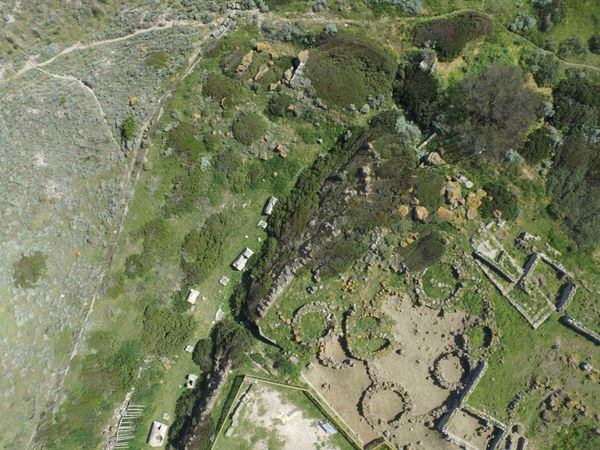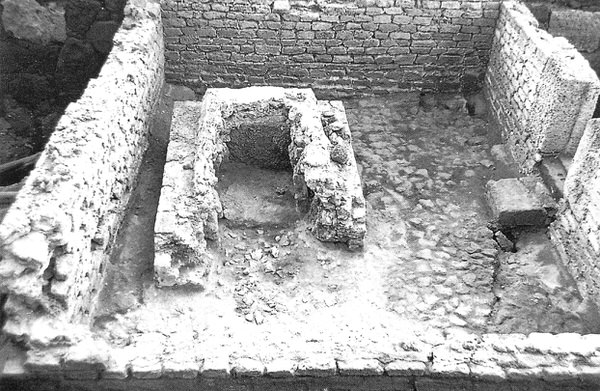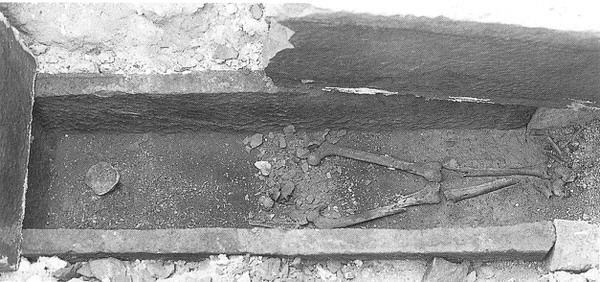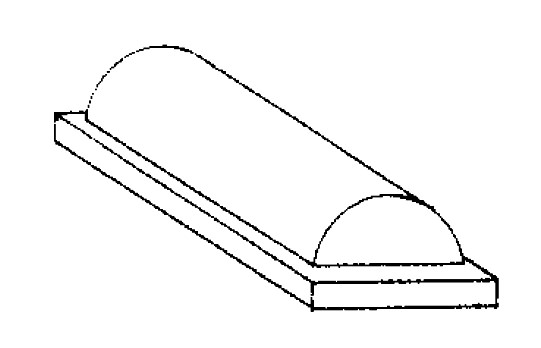The Roman necropolis
Necropolises were arranged around the city of Tharros in the Roman era. Unfortunately nineteenth century digs searching for treasures devastated the Roman tombs, even if they were poorer than the Punic ones, and little evidence is left.
The small amount of information left shows us incineration tombs where the urn containing the ashes was placed inside a cavity dug into the rock. The urn could be made of glass, terracotta, or a small stone box. Coffer tombs or hooded tombs may also have been present. The funeral items date these burials to the full Imperial Age.
Let’s take a closer look at the small necropolis that was set up in the 1st century A.D. in the moat of the Su Muru Mannu fortifications after it was partly filled in (fig. 1).

A small mausoleum stands out in this necropolis, comprising a fence of stone blocks and poorly paved with irregular stones, inside of which there is a cupae tomb that was already plundered in ancient times, lying over a small stone box containing the bones of the deceased (figs. 2-3), dated to the final decades of 1st century, A.D.


All the other toms, which are mostly in the northern part of the moat, are cupae, i.e. With a semi-circular covering (figs. 4-6)



These tombs were finished with a smooth white plaster, and sometimes painted to imitate marble slabs that lined the tombs of the higher class’ tombs (fig. 7) In a few cases, there is a small shelf opposite the tomb, in concrete, plastered stone, used for the symbolic meal in the memory of the deceased person (fig. 8).


The cupae tomb, in well-finished cement, covered the tomb that could have been a cappuccina tomb, with dual sloping tiles (fig. 9) or a simple stone box.

Examination of a small number of funeral goods found in these tombs, still not revealed, dated them to the 1st century A.D. and the early decades of the 2nd.
The cupae tombs are widespread in the western Mediterranean and Sardinia contains a large number, equally distributed in the various urban areas.
Bibliografia
- L. BACCHIELLI, Monumenti funerari in forma di cupola: origine e diffusione in Italia meridionale, in L’Africa Romana, III, 1986, pp. 303-319.
- A.M. GIUNTELLA, Cornus I, 1.L’area cimiteriale orientale, Oristano 1999.
- E. ROMANÒ, Le tombe ‘a cupa’ in Italia e nel Mediterraneo. Tipologia architettonica, committenza e rituale, in Studi Classici ed Orientali, LII, 2006 (2009), pp. 149-219.
- C. TRONCHETTI, Tharros – Lo scavo della postierla e dell’edificio funerario nel fossato – Anno 1981, in Tharros XXIV – Rivista di Studi Fenici XXV (supplemento), 1997, pp. 39-42.

 VR
VR